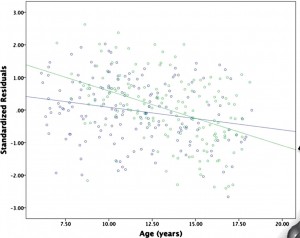Two types of brain image study
If a brain imaging study finds greater activation in the asymmetric diplodocus region or increased thinning in the posterior homiletic, what does that mean?
There are two main possibilities. Some studies look at groups who are different and try to understand why. Other studies try to use brain imaging as an alternative to measuring actual behaviour. The story in the Herald (from the Washington Post), “Benefit of kids’ music lessons revealed – study” is the second type.
The researchers looked at 334 MRI brain images from 232 young people (so mostly one each, some with two or three), and compared the age differences in young people who did or didn’t play a musical instrument. A set of changes that happens as you grow up happened faster for those who played a musical instrument.
“What we found was the more a child trained on an instrument,” said James Hudziak, a professor of psychiatry at the University of Vermont and director of the Vermont Center for Children, Youth and Families, “it accelerated cortical organisation in attention skill, anxiety management and emotional control.
An obvious possibility is that kids who play a musical instrument have different environments in other ways, too. The researchers point this out in the research paper, if not in the story. There’s a more subtle issue, though. If you want to measure attention skill, anxiety management, or emotional control, why wouldn’t you measure them directly instead of measuring brain changes that are thought to correlate with them?
Finally, the effect (if it is an effect) on emotional and behavioural maturation (if it is on emotional and behavioural maturation) is very small. Here’s a graph from the paper

The green dots are the people who played a musical instrument; the blue dots are those who didn’t. There isn’t any dramatic separation or anything — and to the extent that the summary lines show a difference it looks more as if the musicians started off behind and caught up.
Thomas Lumley (@tslumley) is Professor of Biostatistics at the University of Auckland. His research interests include semiparametric models, survey sampling, statistical computing, foundations of statistics, and whatever methodological problems his medical collaborators come up with. He also blogs at Biased and Inefficient See all posts by Thomas Lumley »